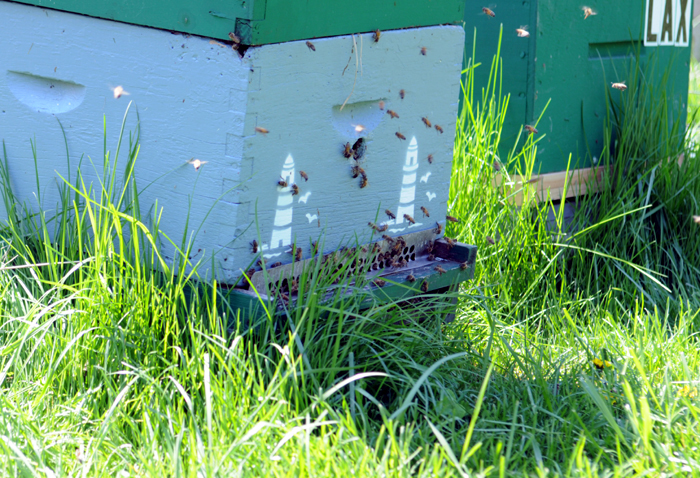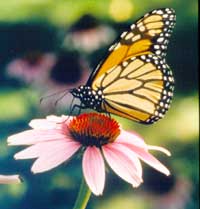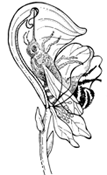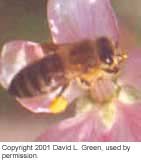






We host a set of beehives that sit along the edge of our property in Burlington, VT. The resident honeybees make sure our gardens are well-pollinated.

Monarch butterfly
How many times have you seen a bee in your garden, buzzing from one snapdragon or squash blossom to another? At each visit the bee almost disappears into the flower as it uses its long tongue to lap nectar hidden deep within the flower. When it backs out, tiny bits of pollen are stuck to its hairy body.
Gardening for pollinators allows us to understand and appreciate a part of nature we usually don't notice: the insects. Once you start paying attention, you will find a whole world that is even more complex, fascinating and important than any of us realize.
Through simply looking for food, thousands of species of bees and other insects and animals help plants to reproduce. Of the estimated 240,000 flowering plants worldwide, 91 percent require an insect or animal to distribute their pollen in order to set fruit and seed. That includes one-third of all crops grown for people, including citrus fruits, almonds, berries, squash and cotton.
Most people recognize that bees are important pollinators. But that’s not all. Many species of butterflies, bats, birds, moths, flies and even mammals are also pollinators. They are so essential to reproduction that most of the world's plant life could not exist without them.
Despite the critically important service they provide, pollinators have been taken for granted and they are in jeopardy. According to the U.S. Department of Agriculture, we are facing an "impending pollination crisis," in which both wild and managed pollinators are disappearing at alarming rates.
In the U.S. the number of honeybees has decreased by 25 percent in the past decade due to a parasitic mite. Meanwhile, wild pollinators are threatened by habitat loss, pesticide use and disease—just as researchers are learning how valuable and efficient many of these pollinators are.
You can help improve the plight of pollinators, starting in your own backyard. Imagine a patchwork of pollinator gardens all across the country—building diverse communities of beneficial insects.
A Pollination PrimerFlowers inspire people. From the tulipmania of 17th century Europe and obsessive orchid collecting two centuries later to the millions of avid gardeners around the world who now spend every moment of spare time tending their flowers.
But while some of us live for flowers, they certainly don't exist for us. They exist to lure pollinators—the bees, butterflies, flies, bats, birds and many other animals that facilitate sexual reproduction.
Flowers are the reproductive organs of a plant. When the insect lands on the flower and searches for nectar and pollen to eat, tiny pollen pieces on the anther—the male part of a flower - stick to the body of the insect. When the insect goes to another flower, some of that pollen sticks to that flower's stigma—the female part of the flower. That pollen then fertilizes the ovules which leads to seed production.
The Real Purpose of FlowersOver the last 100 million years, flowers have evolved an extraordinary range of strategies to facilitate the work of pollinators, from color and scent to petal design and bloom time.
Lilies have ridged petals to guide bees to the nectar-rich center; concentric rings on blanket flowers create a target focused on the nectar; zinnias and butterfly weeds have flat topped clusters of flowers to attract butterflies; delphiniums have a special petal that serves as a landing platform for bees.
Let's look more closely at one example of an insect and flower partnership: monkshoods (Aconitum spp.) and bumblebees. Monkshoods are entirely dependent upon bumblebees for pollination. They are also beautifully adapted to a bumblebee's needs. 
As the name suggests, the petal-like sepals of each monkshood blossom form a hood-like cover concealing two long spurs with huge nectar-filled nectaries at the end. These nectar loads can only be reached by the long tongues of bumblebees. And when the bumblebee enters the blossom, it must walk over the male (pollen covered anther) and female (sticky stigma) parts of the flower. Without a visit from a bumblebee, monkshood would be unable to set seed and reproduce.
Look closely at some of the flowers in your yard and see if you can see the specialized ways in which the flower attracts pollinators.
More information: Attracting Butterflies, Hummingbirds and Other Pollinators.
Meet the Pollinators
Honeybee
Thousands of different species helps plants pollinate, from bees, butterflies and ants to bats and birds. Listed here are some of the most important pollinators in the U.S. and the ones you are most likely to see in your backyard.
Bees are the world's workhorse pollinators, with over 40,000 different species worldwide and 4,000 in the U.S. alone. They carry and deliver pollen grains to more flowering plants than any other group. And bees are well adapted to this task. Their hind legs are hairy to hold pollen. Some species also have special sacs on their legs which hold pollen.
Bees are able to visit dozens or hundreds of flowers in one day searching for nectar and pollen. They are especially attracted to brightly colored yellow and blue flowers with a sweet fragrance. Bees will land on tube shaped flowers and crawl inside.
While honeybees are the best-known bee, most pollination is actually done by wild solitary bees, like mason bees, that do not live in hives.
Honeybee (Apis mellifera)
The honeybee is a European species of bee that was introduced to North America in colonial times. Today, U.S. beekeepers tend over 3 million colonies of honeybees. Those honeybees are generalists, which means they visit many different kinds of flowers, from fruit trees to clover.
Bumblebee (Bombus spp.)
The large bumblebees you see flying in the early spring are queens just out from hibernation. They have emerged from their long underground hibernation and are feeding and looking for an underground cavity to nest in. Later in the summer, you will see the worker bumblebees out foraging.
Unlike honeybees, bumblebees are capable of something called buzz pollination. This is when the bee lands on a flower and vibrates very quickly, stimulating the anther to release even more pollen.

Mason bee
Mason Bee (Osmia spp.)
Mason bees can be found throughout most of the United States. They are solitary and nest in hollow stems, woodpecker drillings and insect holes in trees. They are common near woodlands, in towns and suburbs and are excellent pollinators of many plants.
Squash Bee (Peponapis spp.)
Squash bees are well-adapted specialists. For example, the hoary squash bee depends entirely on squash and pumpkin. These bees are solitary and nest in burrows in the ground that approximately 10 inches deep and about the diameter of a pencil.
Butterflies are some of the world's most beautiful pollinators. In the U.S. there are about 700 different species. Butterflies love brightly colored yellow and pink flowers and those with flat-topped clusters of flowers that they can land on. They have a long proboscis which they will use to probe deep into flowers searching for nectar.
Monarch Butterfly (Danaus plexippus)
Perhaps the best known butterfly is the monarch. The larval sate (a green and yellow striped caterpillar) feed almost exclusively on milkweed, although the adult butterflies visit many different kinds of flowers. Monarchs migrate each year between the U.S. and Mexico and so there are many vital pockets of habitat along their migration route.
Zebra Heliconian Butterfly (Heliconius charitonius, sometimes called a "longwing")
Unlike most butterflies, zebra heliconians feed not only on nectar, but are also able to collect and consume pollen with their proboscis. They digest the pollen, and absorb its proteins. This extra nutrition allows the adult swallowtail to mate, lay eggs and survive for as long as 6 months.
Flies pollinate a huge variety of flowers, including many common garden flowers. Many syrphid flies visit tiny flowers.

Syrphid fly
Syrphid Fly (Syrphidae spp.)
In order to avoid predation by birds, many species in this family have evolved to look and even behave like bees. These flies are present throughout the growing season but are particularly common in the spring and fall.
Moth are less showy than butterflies, but even more numerous with 10,000 different species in the U.S. Unlike most other pollinating insects, moths are active primarily at night. They are attracted to white or light colored flowers with a strong, sweet scent, such as nicotiana, datura, moonflowers and various yellow evening primroses.
Hawkmoth (Manduca spp.)
Large hawkmoths the size of hummingbirds pollinate jimsonweed—the largest native flower in the U.S.—at night.
Hummingbirds are the most spectacular of the common pollinators, with their often iridescent plumage and spectacular flight displays. Hummingbirds are most attracted to nectar-rich red tubular flowers.
Ruby-Throated Hummingbird (Archilochus colubris)
The tiny ruby-throated hummingbird weighs only a tenth of an ounce, but can consume 50 percent of its weight in nectar a day.
Bats are the world's most important pollinating mammal. While most bats in the U.S. feed on insects, there are several species in the southwestern U.S. that feed on fruit and nectar and are vital pollinators of desert plants, especially cacti.
Lesser Long-Nosed Bat (Leptonycteris curasoae)
This bat is one of the primary pollinators of the magnificent saguaro cactus. The migrating bats pollinate the cactus flowers as they feast on nectar. Later in the summer, they eat the fruit of those same plants and help disperse the seeds. This bat is only about three inches long, but its tongue can be as long as its body.
Copyright © www.100flowers.win Botanic Garden All Rights Reserved